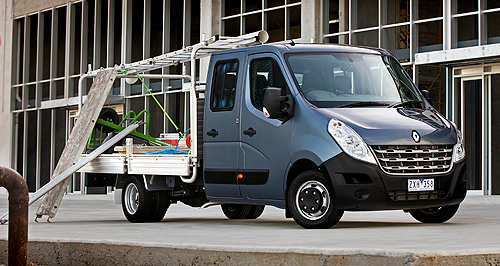Renault boosts Master range
BY MIKE COSTELLO | 8th Nov 2013

The new rear-drive Master variants are the first sold here in that configuration. The mega-sized High Roof version has 36 per cent more cargo space than the previous largest front-drive version, while the cab chassis models come in either three- or seven-seater bodystyles.
Renault ambitiously claims these ute versions “offer twice the payload and up to twice the load-space of a regular ute, yet at a comparable price” of $45,490 plus on-road costs (single cab) or $50,490 (dual-cab).
Having put greater emphasis on LCVs this year through more advertising, sharper pricing and the forging of key fleet deals - most notably with Australia Post, having usurped the incumbent Mercedes-Benz with an aggressive pricing arrangement - Renault has grown volume of its three-member commercial range by 77.5 per cent, with 1704 units registered.
This figure means that LCVs, meaning the Kangoo small-van, Trafic mid-sizer and Master heavy van, account for about 30 per cent of total Renault sales in 2013, which are up 38.3 per cent on the marque’s 2012 figure - itself a record since its relaunch here in 2002.
The Master accounts for 627 of those sales this year, up 78.1 per cent, with the biggest Renault on-sale eating into established players such as the Mercedes-Benz Sprinter.
The extra long, extra tall new Master variant, called the High Roof, sits atop the range priced from $50,990 plus on-road costs in six-speed manual guise (or an extra $2000 when paired with the Quickshift robotised manual). This is $6000 more expensive than the FWD, LWB version.
It offers 17m3 of load capacity, equal to 36% more space than the LWB version immediately below it, and a payload of 2134kg that is a full 500kg more than the largest (front-wheel drive) Master van available up to now. It also has a hefty 3000kg towing capacity.
It comes as standard with a driver’s suspension seat, made by Isringhausen, to soak up the bumps on long commutes, and also features standard dual-rear wheels.
As with the rest of the range, power comes the Euro 5 emissions-compliant 2.3-litre turbo-diesel direct injection four-cylinder engine, producing 110kW and 350Nm of torque, between 1500rpm and 2750rpm.
The 4500kg Gross Vehicle Mass (GVM) means that holders of regular passenger car licences can drive this version too.
The High Roof shares its wheelbase with the pre-existing LWB model at 4332mm, but the rear overhang has been extended to 1674mm (up from 1024mm), allowing an interior load length of 4383mm for a vehicle that is 6848mm long stem to stern.
The cargo bay shares the same 1765mm width of all Master vans, but offers an internal height of 2048mm, up from 1894mm. Exterior height is a tall 2808mm. The rear doors open to 270-degrees to allow ease of loading by forklift. The left-hand sliding side door is 1270mm wide and 1684mm high, with an optional driver’s side sliding door, both of which can be ordered with or without glazing.
Standard features include dual front airbags, ABS with EBD, ESC with ASR traction control, cruise control and speed limiter, a steel bulkhead with window to deaden noise and protect the occupants, remote central locking, multi-function trip computer, Bluetooth hands-free with audio streaming and reverse parking sensors.
Options packages add features such as auto headlights and rain sensing wipers, dual side airbags (where the suspension seat is a delete option), fog lights and alarm, plus integrated sat-nav, reversing camera, under seat storage compartment, additional large door bin and lidded A4-sized dashtop cubby.
The rear-drive cab chassis versions, meanwhile, features the same powertrain as the rest of the range, and comes with either six-speed manual or a $2500 more expensive ZF Quickshift gearbox.
The 4.5-tonne GVM vehicles come in a choice of two chassis lengths, giving body-builders scope to meet customer requirements, from refrigerated boxes to flat-top trays, while the seven-seat Dual Cab variants allows the entire crew to travel together.
The Dual Cab comes with an Eaton automatic diff lock as standard (optional on Single Cab), to assist traction of loose surfaces.
Both versions have a payload of up to 2.5-tonnes, with an additional 3-tonne towing capacity, thanks to the standard dual rear-wheel set-up using 195/75 R16 tyres on 5.5J 16 rims, and multi-leaf rear suspension.
As with the van, dual airbags, ABS and ESC with ASR traction control, cruise control and variable speed limiter, and a brake pad wear indicator, are all standard fit.
Remote central locking, Bluetooth hands-free connectivity and audio streaming, air conditioning, multifunction trip computer, multiple drinks holders, a chilled glove box, overhead storage and power front windows are all on the standard feature list.
The High Roof’s standard suspension seat can be optioned. Mechanical options include a transmission-driven Power Take Off and a towing pack.
The maximum front axle load is 1850kg while the rear axle takes 3200kg.
Dual Cab versions offer up to seven seats (including a ‘4-across’ rear bench). Single Cab versions have a choice of wheelbases: 3682mm or 4332mm, while the Dual Cab is only available in 4332mm. The longer Single Cab model can be built up to an overall length of almost eight-metres, of which almost 5.5-metres is load area.
All Renault commercials have a three-year or 200,000 kilometre warranty with capped-price servicing, and three years of roadside assist. The service intervals are a high 30,000km.